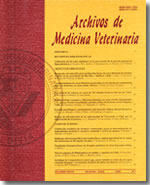Between and within-herd seroprevalence for bovine leukosis virus infection in dairy herds from southern Chile
Main Article Content
Abstract
The objectives of this study were to estimate herd and within-herd seroprevalences against bovine leukemia virus in dairy herds of Región de los Ríos and Los Lagos, and to describe them according to the characteristics of the farm. A cross-sectional study and a random stratified sampling strategy were used. 4,360 blood and serum samples from females older than 6 month and bulls were collected from 75 dairy herds from September to December 2007, and they were processed using a commercial ELISA according to the instructions of the manufacturer. An overall proportion of infected herds (PIH) over total and the apparent prevalence (AP) were estimated by herd size and age group. Overall PIH was 34.7% (CI 95% (22.6; 44.1)) and 23.9% (CI 95% (11.1; 36.7)) for small herds, 43.5% (CI 95% (21.6; 65.4)) for median and 83.3% (CI 95% (40.5; 100.0)) for large herds and the difference was statistically significant (P < 0.05). General AP was 14.6% and the average AP was 5.3% (CI 95% (2.3; 8.3)). Average within-herd AP was 2.1% (CI 95% (0.34; 3.8)) for small herds, 10.13% (CI 95% (10.0; 10.2)) for median and 30.1% (CI 95% (29.9; 30.3)) for large herds and the difference was statistically significant (P < 0.05). The average AP for adults was 5.1% (CI 95% (1.6; 8.6)) and 1.3% (CI 95% (0.4; 2.2)) for young stock. The results suggest that in the area of study, large herds should be the target group for a control programme and the current situation might represent a business opportunity for small farmers by enrolling in a free certification scheme.

